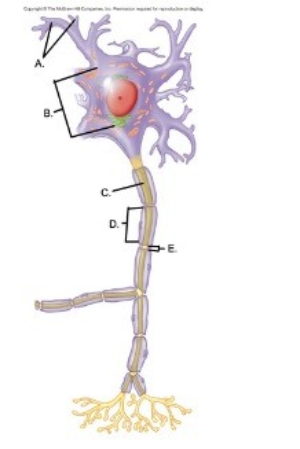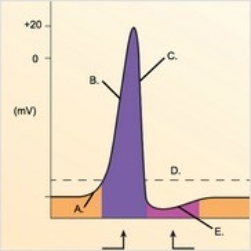A) be a local potential.
B) be an action potential.
C) be a consequence of an increase in the permeability to Na+.
D) result in repolarization.
E) be a local potential and a consequence of an increase in the permeability to Na+.
G) C) and E)
Correct Answer

verified
Correct Answer
verified
Multiple Choice
Match the following concerning concentration differences across the plasma membrane. -K+
A) Concentration of K+
B) Concentration of Na+ and Cl−
C) Negatively charged proteins
D) Sodium-potassium pump
E) Plasma membrane is more permeable to this ion because of leak ion channels
G) All of the above
Correct Answer

verified
Correct Answer
verified
Short Answer
The nervous system has two subdivisions-the central nervous system and the ________ nervous system.
Correct Answer

verified
Correct Answer
verified
Multiple Choice
The opening of more and more Na+ channels during depolarization
A) is the result of the sodium-potassium exchange pump.
B) is an example of a positive feedback cycle.
C) is possible only if K+ channels remain closed.
D) is the cause of the afterpotential.
E) is an example of a negative feedback cycle.
G) A) and C)
Correct Answer

verified
Correct Answer
verified
Multiple Choice
Match the glial cell with its function. -Astrocytes
A) Influence function of blood-brain barrier
B) Macrophages in CNS
C) Produce cerebrospinal fluid
D) Form myelin sheath around axons in CNS
E) Form myelin sheath around part of the axon in the PNS
G) D) and E)
Correct Answer

verified
Correct Answer
verified
Multiple Choice
Cell bodies of the peripheral nervous system are located in
A) ganglia.
B) Schwann cells.
C) the motor division.
D) the sensory division.
E) nerves.
G) A) and B)
Correct Answer

verified
Correct Answer
verified
Multiple Choice
Enkephalins produce presynaptic inhibition in neurons transmitting pain signals. Increased levels of enkephalins will
A) increase awareness of pain.
B) decrease awareness of pain.
C) increase amount of pain.
D) decrease amount of pain.
E) have no effect on awareness or amount of pain.
G) C) and E)
Correct Answer

verified
Correct Answer
verified
Multiple Choice
When a neuron releases a neuromodulator that ________ the release of neurotransmitters from another neuron, this is called presynaptic facilitation.
A) increases
B) decreases
D) undefined
Correct Answer

verified
Correct Answer
verified
Multiple Choice
Rapid removal or destruction of neurotransmitter in the synaptic cleft
A) may affect the ability of the postsynaptic membrane to generate action potentials.
B) generates local potentials in the presynaptic terminal.
C) is necessary for synaptic transmission.
D) may lead to action potentials.
E) may stop exocytosis.
G) A) and B)
Correct Answer

verified
Correct Answer
verified
Multiple Choice
Which of the following statements concerning resting membrane potential is true?
A) The resting plasma membrane is more permeable to Na+ than K+.
B) The resting membrane potential never reaches an equilibrium point.
C) The resting membrane potential is proportional to the tendency for K+ to diffuse out of the cell.
D) Negatively charged Cl− ions are attracted by negative charges in the cell.
E) The purpose of the sodium-potassium pump is to create an equilibrium of ion concentrations.
G) A) and E)
Correct Answer

verified
Correct Answer
verified
Multiple Choice
Which neurotransmitter is released at neuromuscular junctions?
A) Serotonin
B) Acetylcholine
C) Dopamine
D) Glutamate
F) A) and C)
Correct Answer

verified
Correct Answer
verified
Multiple Choice
Protein synthesis in neurons occurs in ________.
A) axons
B) dendrites
C) cell bodies or soma
D) presynaptic terminals
E) nodes of Ranvier
G) D) and E)
Correct Answer

verified
Correct Answer
verified
Multiple Choice
Monamine oxidase inhibitors (MAO inhibitors)
A) prevent synaptic transmission.
B) enhance the breakdown of norepinephrine.
C) enhance the binding of norepinephrine to its receptors.
D) prevent the release of norepinephrine by the presynaptic terminal.
E) have no effect on the action of norepinephrine.
G) A) and C)
Correct Answer

verified
Correct Answer
verified
Multiple Choice
What type of neuroglial cells provide support and nutrition to sensory ganglia in the PNS?
A) Schwann cells
B) Microglia
C) Ependymal cells
D) Satellite cells
F) C) and D)
Correct Answer

verified
Correct Answer
verified
Multiple Choice
Match the glial cell with its function. -Ependymal cells
A) Influence function of blood-brain barrier
B) Macrophages in CNS
C) Produce cerebrospinal fluid
D) Form myelin sheath around axons in CNS
E) Form myelin sheath around part of the axon in the PNS
G) C) and E)
Correct Answer

verified
Correct Answer
verified
Multiple Choice
Match the glial cell with its function. -Schwann cell
A) Influence function of blood-brain barrier
B) Macrophages in CNS
C) Produce cerebrospinal fluid
D) Form myelin sheath around axons in CNS
E) Form myelin sheath around part of the axon in the PNS
G) A) and D)
Correct Answer

verified
Correct Answer
verified
Short Answer
 -The figure is a process figure of the chemical synapse. What does "E" represent?
A) Postsynaptic membrane
B) Synaptic cleft
C) Synaptic vesicle
D) Voltage-gated Ca2+ channel
E) Presynaptic terminal
-The figure is a process figure of the chemical synapse. What does "E" represent?
A) Postsynaptic membrane
B) Synaptic cleft
C) Synaptic vesicle
D) Voltage-gated Ca2+ channel
E) Presynaptic terminal
Correct Answer

verified
Correct Answer
verified
Multiple Choice
Neurons that have a single axon and a single dendrite are ________.
A) tripolar
B) bipolar
C) multipolar
D) pseudo-unipolar
F) A) and B)
Correct Answer

verified
Correct Answer
verified
Multiple Choice
Which of these does not contribute to the cessation of the signal in a synaptic transmission?
A) Synaptic vesicles secrete neurotransmitter by exocytosis.
B) Neurotransmitter escapes from the synapse into the nearby extracellular fluid.
C) Neurotransmitters are no longer released.
D) The axon terminal reabsorbs some neurotransmitters by endocytosis.
E) Enzymes in the postsynaptic cell break down some neurotransmitters.
G) A) and B)
Correct Answer

verified
Correct Answer
verified
Short Answer
 -The figure illustrates changes in the membrane potential during an action potential. What does "C" represent?
A) Repolarization
B) Depolarization
C) Local potential
D) Threshold
E) Afterpotential
-The figure illustrates changes in the membrane potential during an action potential. What does "C" represent?
A) Repolarization
B) Depolarization
C) Local potential
D) Threshold
E) Afterpotential
Correct Answer

verified
Correct Answer
verified
Showing 161 - 180 of 192
Related Exams